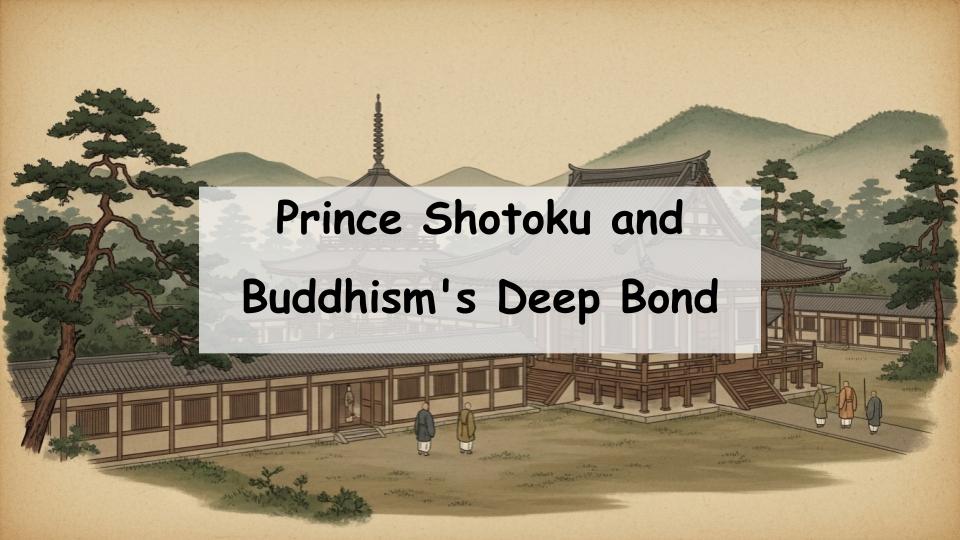“Why is Prince Shōtoku so closely associated with Buddhism?”
“What temples did he build, and what was his goal?”
Many people have these questions. While most have heard of Prince Shōtoku in school, few understand exactly how he embraced Buddhism and what he aimed to achieve by constructing temples.
In short, Prince Shōtoku regarded Buddhism as a source of national stability and spiritual guidance. By deepening his own faith, he sought to merge politics with religion. The temples built during his era stand as tangible symbols of his ideology and practice.
This article explores how Prince Shōtoku became involved with Buddhism and why he established numerous temples. We’ll also introduce the major temples he founded and their roles, examining the lasting influence he had on Japanese Buddhism. If you’re interested in Shōtoku or Buddhist history, this is the perfect read to deepen your understanding.
Who Was Prince Shōtoku? His Life and Historical Context
Politics and Culture in the Asuka Period
Prince Shōtoku lived during the Asuka Period, a time when Japan was beginning to move toward centralized governance. This era saw increased cultural exchange with China and Korea, bringing in foreign ideas such as Buddhism and Confucianism. The introduction of Buddhism in the mid-6th century marked a pivotal cultural shift, setting the stage for Shōtoku’s religious initiatives.
His Background and Political Role
Born in 574 as the son of Emperor Yōmei, Shōtoku (also known as Prince Umayado) served as regent to Empress Suiko. He envisioned a nation guided by Buddhist principles and took an active role in politics to realize this ideal. His commitment to faith went beyond personal belief—it influenced the structure of government itself.
The Seventeen-Article Constitution and Political Reform
In 604, Prince Shōtoku issued the Seventeen-Article Constitution, blending Buddhist and Confucian values to outline a moral foundation for governance. This document emphasized harmony and duty, making Buddhism a central pillar of political ethics and national unity.
Prince Shōtoku’s Engagement with Buddhism
Why He Embraced Buddhism
Shōtoku saw Buddhism as a unifying spiritual force, capable of bringing order and stability to a fragmented society. At a time when clan rivalries threatened peace, Buddhist teachings offered a framework for collective ethics and compassion.
His Policies to Promote Buddhism
He actively supported Buddhism through various policies: protecting monks, promoting scripture studies, and building temples. By integrating Buddhism into the fabric of political life, he elevated it from foreign import to national creed.
Relationship with Confucianism and Shinto
While Buddhism gained prominence, Shōtoku did not reject other traditions. Instead, he sought balance: Confucianism provided social ethics, Buddhism gave spiritual depth, and Shinto remained tied to traditional rituals. This triad of beliefs laid the foundation for Japan’s religious identity.
Temples Founded by Prince Shōtoku and Their Role
Hōryū-ji: The Oldest Wooden Structure in the World
Hōryū-ji, initiated by Shōtoku, is considered the world’s oldest wooden building. More than a religious site, it served as a manifestation of his Buddhist vision—a visible testament to harmony, order, and sacred architecture.
Shitennō-ji: Symbol of Diplomacy and Propagation
Located in Osaka, Shitennō-ji reflects Shōtoku’s diplomatic and religious ambitions. Dedicated to the Four Heavenly Kings, it represented protection of the state and the spread of Buddhism through peaceful exchange with neighboring countries like Baekje and Goguryeo.
Other Temples: Chūgū-ji and Tachibana-dera
Chūgū-ji, associated with his mother, and Tachibana-dera, linked to his birthplace, also reveal the personal and political dimensions of Shōtoku’s faith. These temples stand as physical expressions of familial devotion and moral governance.
The Political and Philosophical Message in Temples
Temples were not mere religious centers. They communicated values, reinforced royal authority, and symbolized divine support for political order. Shōtoku used sacred space to legitimize his leadership and unify the people under shared beliefs.
Shōtoku’s Buddhist Thought and Its Influence
Connection to the Bodhisattva Ideal
Shōtoku was regarded as a living Bodhisattva—one who seeks enlightenment not for personal gain, but to benefit others. His rule reflected this ideal, focusing on compassion, selflessness, and moral governance.
“Harmony Is to Be Valued”: Spiritual Implications
His famous quote, “Harmony is to be valued,” was not just political advice. It captured the Buddhist ethos of coexistence and mutual respect, providing a spiritual blueprint for a peaceful society.
Long-Term Impact on Japanese Buddhism
Prince Shōtoku’s policies and institutions formed the bedrock of Japanese Buddhism. His legacy influenced the structure of temples, monastic education, and the integration of Buddhism into state affairs during later periods like Nara and Heian.
The Importance of Understanding Shōtoku and Buddhism
To Grasp Japan’s Religious Culture
Studying Prince Shōtoku helps one understand how Japan’s unique religious landscape evolved. Buddhism’s adaptation alongside Shinto and Confucianism shaped the cultural and moral foundations of the nation.
Modern Faith and the Enduring Image of Shōtoku
Even today, Prince Shōtoku is revered as a cultural icon and spiritual figure. Sites like Hōryū-ji and Shitennō-ji attract pilgrims and tourists alike, keeping his memory alive in both religious and secular contexts.
Educational, Religious, and Cultural Value
Exploring Shōtoku’s connection to Buddhism offers insights for travelers, students, and spiritual seekers. It enhances temple visits, deepens classroom learning, and fosters a respectful understanding of Japan’s religious heritage.









Comment